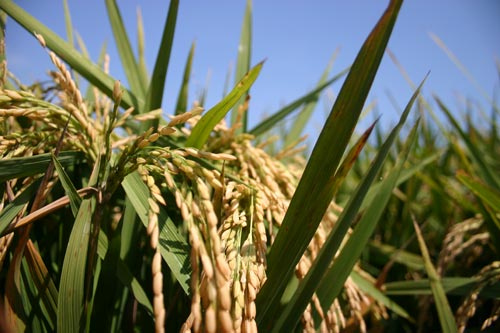May 31, 2011

If there was one positive from the poor-quality rice crop of 2010, it is that scientists were able to develop a better understanding of the effects of high nighttime temperature on rice grains.
Research by University of Arkansas Division of Agriculture scientists on the impact of high nighttime temperatures on rice grain quality in 2010 was presented at the annual Industry Alliance Meeting of the university’s rice processing program May 25-26.
The program in the John W. Tyson Building auditorium had a record attendance of about 100 persons representing companies and farmer cooperatives in 10 states and seven countries. Companies involved in rice processing and the Arkansas Rice Research and Promotion Board support rice processing research.
“The historically poor quality of rice in 2010 extended our data set to strengthen our understanding of nighttime temperature effects,” said Terry Siebenmorgen, rice processing program director and professor of food science at the University of Arkansas. Variation in grain quality from year to year is a long-term research topic, he said.
Milling yield, which is the yield of whole kernels after removal of the hull and bran, was the lowest on record in all Delta rice-growing states in 2010, according to USDA.
Central Arkansas endured its hottest summer on record in 2010, with an average daily (day and night) temperature in Little Rock from June through August of 85.8 degrees, compared to the average of 80.7, according to the National Climatic Data Center.
The critical “grain-filling” stage of rice kernel development occurred in many rice fields when nighttime temperatures were at historically high levels, said Paul Counce, a Division of Agriculture plant physiologist based at the Rice Research and Extension Center near Stuttgart, Ark. Counce and colleagues developed the definitive model that identifies the stages of rice plant and grain development.
Studies by Counce and others have documented that high nighttime temperatures interfere with kernel development during the grain filling stage.
Kernels are formed by the conversion of plant sucrose to starch, and they should be translucent when the bran layer is removed by milling. Kernels that are exposed to high nighttime air temperatures during kernel formation develop areas that may appear chalky, or opaque. Chalky kernels tend to break during milling, and they are inferior as packaged rice for consumers and for processing into cereal and other products.
“The more we understand what’s happening, the closer we are to developing ways to avoid or reduce dramatic swings in grain quality and yield due to temperature variations,” Counce said.
Grain quality of the Cypress long-grain variety and Bengal medium-grain variety was not significantly affected by high nighttime temperatures, Counce said. This finding indicates that resistance to high nighttime temperatures is a genetic trait that might eventually be bred into a wide range of improved varieties.
Of particular interest is the genetic coding of enzymes that are active in the conversion of plant sucrose to starch, Counce said. The starch synthase enzyme, which is critical to building starch molecules in the kernel, is significantly affected by high nighttime temperatures, he said.
Arkansas farmers produce nearly half of the rice grown in the United States. Most producers are members of farmer-owned processing and marketing cooperatives based in Arkansas.
You May Also Like




